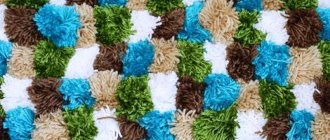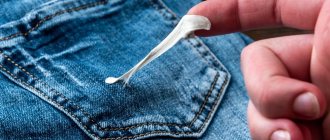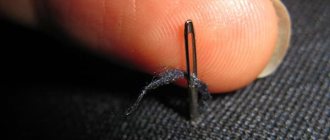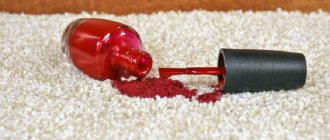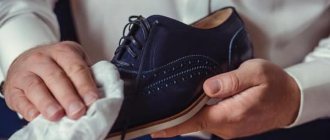For the overall look to be perfect, there should be no defects in the stockings and tights. If a tightening occurs at the most inopportune moment, simple techniques that every woman should know about will help cope with the problem.
We will tell you in this article how to remove a puff on nylon tights.
The problem is when stripes and arrows appear on tights
Often this happens at the wrong time. An effective, but not the best solution would be to take a spare pair of tights with you. It is much easier to buy new thin tights than to try to sew up old ones. The method for eliminating arrows is related to where exactly the snag occurred. It’s always easier to fix a problem like this at home. The easiest way is to eliminate the transverse puffs. They are removed by smoothing and stretching. They need to be carefully stretched lengthwise and crosswise. Provided that there was no damage to the thread, the puff will disappear. When there is damage to the nylon thread, this will lead to the appearance of an arrow.
Recommendations
The following recommendations will help in the fight against tights
You should only purchase tights that are the right size. You can check the size chart on the product packaging.- High-quality tights last longer and are less likely to form puffs.
- Composition matters.
The elastane (lycra) in the composition is responsible for elasticity and resistance to deformation. For tights with a density of up to 100 den, the optimal elastane content is from 10%. For denser ones this figure is usually lower. - The thinner the tights, the higher the likelihood of puffs. Therefore, they should be worn very carefully.
- If the tightening is noticeable and cannot be eliminated using simple methods, the tights will need to be replaced.
- Before first use, new tights, especially if they are not of very high quality, can be sprayed with hairspray.
On dark thin tights, the puffs are much more noticeable than on the same, but flesh-colored ones.
Hooks
02/13/2016 bracatuS (2288 articles) The drawstrings on the tights look very sloppy.
The hooks can quickly become holes, from which arrows crawl up or down the tights, and sometimes absolutely nothing happens to the hooks and they just continue to be on the tights. It happens that some no name tights, bought for the occasion, quickly become completely covered with puffs, but do not tear. It’s a shame to throw them away - they don’t tear! - but it’s also impossible to wear. If a woman continues to wear tights in puffs, this does not at all indicate her ability to save money. Such a housewife probably has old towels with holes in her kitchen that look more like rags, and the dishwashers should have been mercilessly thrown away long ago.
Of course, it happens that a snag appears on tights unexpectedly: because of a handbag, boots, a bad manicure, you never know! But there may be 1-2 such clues, but not a dozen in different places on the tights.
Cat and dog hair pellets
Pets, even without meaning to, sometimes bring a lot of trouble to their owners. For example, cat and dog hair gets on clothes, falls off, and forms pellets. But this is not a problem that you should worry too much about - animal hair pellets are removed quite easily. The main thing is to do it in a timely manner.
If the wool is already stuck, a special roller with an adhesive surface will help you out. Just run the roller over your clothes (as well as the carpet or sofa seat) and all the hair stuck to the fabric will be on it.
You can make such a roller yourself. To do this you will need: Wrap the bottle with tape so that the adhesive side is on the outside.
Excessive friction is the enemy of tights
Any irregularities on the toes or inside the shoes cause excessive friction. Friction can form snags that quickly turn into arrows.
Every time before putting on or taking off tights, check to see if your fingernails are broken or if there are any hangnails on your skin. Before putting on tights, it is better to once again run your hands along your legs from the very tips of your toes to the waist and make sure they are smooth. Some even lubricate their hands with cream or lotion before putting on tights. It might make sense to do this. In any case, the cream won't hurt the tights.
Kinds
How to remove a puff on tights? Here you need to know what type of product you are dealing with. There are several types of tights:
- Thermal tights. They are made from several types of fibers (a mixture of synthetics, wool, elastin, cashmere, etc.).
- Therapeutic (a special type of tights with antiseptic impregnation, intended for women with varicose veins).
- Openwork, decorative (with a pattern, mesh).
- Knitted (similar to knitted, made from wool, half-woolen, cotton threads).
- Elastic (nylon).
It is not possible to remove the puff from all types of tights. The easiest way to do this is on knitted, warm, therapeutic, decorative, and openwork models. The most difficult thing to deal with are elastic transparent tights. The lower the density, the more difficult the task.
If your tights are from 5 to 40 den, you will have to abandon the idea, or resort to radical measures (read below), since, alas, it will not be possible to completely restore the fabric. But the 50 den models still have a chance to “live” for some time.
You can also “conjure” tights with weaves (with mesh, openwork knitting). This is the so-called fantasy option. If you try a little, it can be restored. Let's consider the available methods.
How to remove puffs
The appearance of a small snag or puff cannot be left unnoticed. If they are not removed in a timely manner, arrows and other damage may occur on the trousers.
By using available materials, protruding threads and snags can be quickly eliminated.
Gently stretch the small hook
First of all, you can try the standard method. Gently pull the product in different directions.
If the tightening is not too tight, this process can help reinsert the thread and return the product to an attractive appearance.
Using a sewing needle
The most popular is to remove puffs using a regular sewing needle.
- The product must be carefully straightened
. For reliability, you can place it on a hard and level surface. A table would be an excellent option. - Insert the needle in the tightening area so that the eye remains on the outside
. - We hook the protruding thread into the eyelet and pull it to the wrong side
.
A couple of minutes, and the surface of the trousers is smooth again and without visible damage.
Wool, knitwear
When working with knitted items made from wool or knitwear, it is better to use a crochet hook instead of a needle.
. It differs from a regular crochet hook in that it has a lock.
You can buy one in a specialized store.
Chiffon
To repair damage to chiffon trousers, it is recommended to use a fine needle
to prevent further defects from occurring.
After work, the product must be steamed with an iron.
turned on to the appropriate mode for the fabric.
Atlas
Satin material has a rather capricious structure. If defects appear on a satin product, it is better to contact a specialized studio.
try to remove the puff using a steam iron
. To do this, it will be enough to treat the fabric several times with a hot sole on the wrong side.
- When using the needle method, it is not recommended to trim the tail of the protruding thread
. This may cause arrows or holes to appear, which will ultimately ruin the attractive appearance of the product. - In general, it is better to avoid using scissors in the process of removing snags
. Cutting the protruding thread will make the situation worse. - After carrying out the elimination process, it is recommended to slightly steam the product with an iron with a mode suitable for the fabric
. This will smooth out the fabric and finally eliminate the area of deformation. - For a more reliable fixation when removing a tightening on a knitted product, you can carefully hem the loop
using a needle and thread that matches the color scheme. - If there are puffs from washing, it is better to refrain until the defects are eliminated
. During the washing process, the protruding thread may finally unravel. This will lead to the appearance of holes or arrows on the trousers. - Using a special delicate washing mode
will avoid the appearance of unpleasant loops. - Claw marks are almost impossible to remove at home
. In this situation, it is better to contact a specialized studio.
Removing pills from fabrics
Another defect accompanying puffs that forms on the surface of the dress is lint intertwined into a small ball.
Knitted and synthetic fabrics are prone to this phenomenon. The pellets do not affect the strength of the material, but they spoil the beauty of the clothing: it gives the impression that the dress has been worn for a long time. To remove formations from lint, small brushes with a sticky roller inside are made, which are sold in a sewing supply store. The mechanism is simple to use:
lay out the dress on the table;
run the machine from the top of the clothing to the bottom and back;
repeat the procedure until all the pellets disappear.
To remove strands of lint from large knitted items, this method is not needed: the strands are simply cut off with nail scissors. Another source of pellets is pet hair. A mechanical brush will also cope with them, but periodically the mechanism must be cleaned of the fibers accumulated inside. Regular washing will not get rid of puffs and pills.
Heating tights with an iron
Another way to strengthen new tights and extend their service life. In principle, it is even simpler than the first. All you need is an iron. Set the iron to high temperature and carefully iron the new tights through the fabric.
By thermally treating tights, you will strengthen the fibers and also protect the product from holes and snags.
Stopping the arrow with varnish
If, due to carelessness, a arrow has formed on your tights, and you need to stop it as quickly as possible, then it is best to use the method using ordinary nail polish. This method is convenient primarily because perhaps every woman has such an item as colorless nail polish in her arsenal.
If the arrow on the tights has started, dip the brush in the varnish and lightly wipe it on the edge of the bottle. Then run it along the tights at the end and beginning of the arrow. This must be done from both sides, since the arrow can creep into any of them. When the varnish dries, you can walk in these tights for some time.
In principle, if you don’t have clear nail polish on hand, you can use colored nail polish. Of course, we are not talking about aesthetics in this case. But if the arrow is in a place that is not visible to others, then why not save the tights in this way.
New solution - office glue
It often happens that creases in tights occur in the office, in an institution where there are practically no means at hand that could save the situation. In this case, we recommend turning to available tools that are available in almost every organization. The most common of them is office glue. It will not only help to cope with the problem of the spread of arrows along the entire length of the stocking, but will also work effectively throughout the entire working day.
- So, we need PVA glue or any other office glue.
- Even a glue stick is suitable for use, so you can safely trust any company that produces these products.
- It is worth treating the entire area around the hole, also touching the edges. It’s convenient that this procedure can be done even without removing the product, that is, on the leg. The glue dries quickly, so that the threads of the product will be protected from further tearing within a short time.
- It is not recommended to delay such mini-repair of the product, since with each movement the hole noticeably spreads.
It is convenient to always carry a small tube of glue in your purse; this will help prevent damage to your tights even in the most unexpected situations.
How to get rid of puffs on tights
A miracle of light industry, without which the female sex cannot imagine their lives, like all hosiery products - knitted products. Tights are nothing more than many hooks and loops connected into one weave. Therefore, the problem of clues should be solved based on this fact.
How to remove puffs on nylon tights
There are several ways to eliminate troubles:
- Minor puffs are removed by straightening the threads. Try stretching the stockings where they tighten. Pull little by little in different directions, interconnected loops around the problem area. Moreover, this can only be done if the hook does not have even a tiny hole.
- Remove more serious defects with a special hook. Needlewomen who knit have such a hook in their arsenal. If you do not belong to the category of knitters, then buy such a hook in the store. This is a kind of needle with a large eye, with a folding tongue on one of the parts of the eye. To remove a pull on 100 den tights, grab the lowest loop on the hook. Then push it towards the loop that came down. Wrapping it around the loose thread will form a new loop. It, in turn, also needs to be raised to the next one. Step by step, you will rise to the end of the problem area.
Advice: When lifting loose loops using a hook, keep the product taut.
In this way you will restore the integrity of the product without breaking a single thread.
- You can solve the problem of how to remove a puff on 40 denier tights only by sewing it up or decorating it. It makes sense to stitch only in an inconspicuous place. Or, if you plan to wear this product under trousers.
Advice
to sew up a puff or crease, take the smallest needle and thread to match the stockings.
You can decorate a light industrial product absolutely anywhere. For symmetry, create the same decor on the other stocking. The main thing is that the basis of the decor should be nylon, but denser than the tights themselves.
How to avoid puffs in tights
It is easier to prevent any problem than to fix it. Many years of wearing nylon and nylon have taught women and girls to follow certain rules when putting on the product. For those who do not know the intricacies of stretching thin hosiery, we will tell you how to put on tights without tightening:
- Remove jewelry and watches first.
- Keep an eye on the condition of your toenails. Inaccurately processed nail tips can create snags.
- collect one stocking in your hands, reaching the toe.
- First, put the nylon sock on your foot.
- then, gradually releasing the nylon from your hands, pull it onto your leg. Straightening at the same time. You can only tighten the product with your fingertips from bottom to top.
Advice
You should buy a nylon product only by size. Choose a product with a gusset made of natural material with a flat middle seam.
Everyone dreams of not having such problems. I would like to buy tights that are resistant to puffs. The most interesting thing is that these thoughts are very correct:
- The quality of the product depends on the quality of the material from which they are made. But unfortunately, there is no such information on the packaging. Therefore, select products based on your own experience. If you have been wearing stockings of a certain brand for a long time without any problems, then when making further purchases, focus on them.
Advice
When buying a light industrial product, pay attention to the drawing in a tense state. The more clearly the tree-like weaving of the threads is visible, the greater the likelihood of purchasing tights without puffs.
- 40, 50, 60 or 70 denier products must contain more than 10% elastane (10, 12, 20). Then the product is less subject to deformation.
- 100 denier products are denser on their own. Polyamide is responsible for their strength. Therefore, elastane content is allowed less than 10%.
Advice
To avoid snags, spray with hairspray every time you put them on.
Removing pills from fabrics
Another defect accompanying puffs that forms on the surface of the dress is lint intertwined into a small ball. Knitted and synthetic fabrics are prone to this phenomenon. The pellets do not affect the strength of the material, but they spoil the beauty of the clothing: it gives the impression that the dress has been worn for a long time.
To remove formations from lint, small brushes with a sticky roller inside are made, which are sold in a sewing supply store. The mechanism is simple to use:
lay out the dress on the table;
run the machine from the top of the clothing to the bottom and back;
repeat the procedure until all the pellets disappear.
To remove strands of lint from large knitted items, this method is not needed: the strands are simply cut off with nail scissors. Another source of pellets is pet hair. A mechanical brush will also cope with them, but periodically the mechanism must be cleaned of the fibers accumulated inside. Regular washing will not get rid of puffs and pills.
girls, tell me! The composition of the item is 65% viscose and 35% nylon. I just bought it, hung it in the closet and secured it with a lock from a neighboring dress :((((
and how to remove strings from a silk blouse? Tell me please!!
Smother all the cats.
Try using a needle with a large eye. Stick it from the outside with the sharp end into the base of the puff (try right in the place where the puff came out, thread in thread)
Then carefully continue inserting the needle until the eye of the needle reaches the material and is level with the tightening. Carefully thread the puff into the eye of the needle and pull the needle out from the inside out
The needle will turn the puff to the wrong side. Take the tail of the tie out of the needle and very lightly tug the material around the tie in different directions; if the thread has been pulled out too much, this will straighten it out a little.
Thanks a lot. The Solomon T-shirt was damaged by the Velcro from the bag, the first time I put it on - 20 puffs on my stomach (that’s how I found out that this delicate fabric is similar in structure to double tights :-)). I fiddled with it for 15 minutes and the T-shirt was back in use. Thanks for the method!
Please help! I have graduation in 3 days, and I put strings on my polyester dress! Tell me, how can I remove the marks from the strings?
And my cat, sliding out of the closet along the curtains, made a puff that stretched horizontally along the entire length. How to remove it? Stretching in different directions did not help. Pulling the tip to the wrong side hardly improved the situation; the tightening remained. What to do?
Help me how to remove a puff from a Siobhan dress
How to remove snags on satin and silk When there is only one snag and the fabric around is not frayed, the situation can be corrected. You will need a thin needle. Use it to carefully pull the loop to the wrong side. Afterwards, the material is pulled several times in different directions so that the thread falls into place. Finally, the satin or silk is steamed with an iron. If a path appears under the tightening or there are several similar damages, you will have to seek help from professionals.
How to remove a snag on knitwear If the problem on a knitwear product is limited to just a snag, then the method described above with a thin needle will help save the situation. If the thread breaks and the loops begin to fall down, the defect is eliminated using a special knitted hook. The track is darned from the bottom up, and the last loop is secured from the wrong side. Finally, the knitwear is ironed and steamed. This is required to hide the renovated area.
How to remove a puff on wool Woolen knitted items are repaired in exactly the same way. If we are talking about clothes made from bouclé threads or products made with embossed knitting, then puffs and tracks from dropped loops can easily be eliminated even with a regular crochet hook. When there is no hook at hand, use a large needle.
What to do with claw holes Cute pets are not well versed in brands and valuable things. They leave clues wherever their “velvet” paws can reach: curtains, down jackets, outerwear, etc. How to be in this case? Advice Do not try to test the strength of a thing by stretching it in different directions, as when removing small puffs. Carefully remove the curtain from the curtain rod, and the clothes from the hanger, wrap them with the damaged part inward, so as not to further injure them. Take them to a repair shop.
Preserving tights with varnish
Back to regular hairspray again. It will be useful not only in cases where arrows have already formed on nylon tights, but also before this unpleasant moment, as a preventive measure. So, take a new pair of tights and hang them outdoors with clothespins. It is best to do this on the balcony. Shake the can of nail polish so that the contents become a homogeneous consistency and begin spraying the tights. Please note that the varnish layer must be thin. Once you have applied it on both sides, let the tights air dry slightly. After a couple of minutes you can put them on. This method is the most effective, but you need to distribute the varnish evenly to avoid streaks.
Super glue
Of course, there is nothing better and faster than superglue. But repairing tights with its help is not always practical. Of course, you can reliably protect the tights from further destruction and, moreover, you can even hide the crease by moving the ends together. But in most cases, no matter how carefully you try to do everything, your hands and fingers may end up in the glue, and the tights will end up simply sticking to your leg. Of course, no one will notice this, but when you get home, taking off such tights will not be entirely pleasant.
Therefore, depending on the situation and where the problem occurred to you, you can choose one of the most suitable options for you. If you wish, you can conduct several experiments at home to be prepared for any situation.
AlinaAuthor of the article
Threads to help you
The ideal solution when the arrow has moved is, first of all, thread and a needle. Sew up the crease with thread - this is the most effective way to save tights. It is better to choose a thread for these purposes that is thin, but at the same time durable, it can be cotton, or it can be with the addition of synthetics. You need to choose a thin needle so that it does not make unnecessary large holes when sewing.
- When sewing up stockings, it is important to be patient and not miss any areas where the threads have broken.
- It is necessary to connect the edges of the arrow with small stitches and move from the beginning to its highest point.
- If along the main length of the product you can sew up stitches in one layer, then on the heel and toe you should sew more tightly, passing more often over one area. This will help avoid re-tearing in places where the tights are stretched - on the foot and on the toes.
- If the tights are torn due to tightening, then you should pay special attention to what contributed to the deformation of the fiber - this could be the zipper of boots, the edges of certain shoes.
- If you often need to wear tights at work, then it would be a good idea to put a small set in your purse - with a needle and thread. It’s enough to choose the most common thread colors and you don’t have to worry about snags and arrows.
What can't you do?
Since thin women's tights are a very delicate item of clothing, the attitude towards them should be appropriate.
Tightness can appear at any time:
- when putting on;
- while wearing;
- due to improper care, etc.
To prevent a random small clue from turning into a big hole with arrows running down your leg, you should remember the following prohibitions:
You can’t just leave a small clue that appears “unattended” and do nothing.
With a high degree of probability, you can expect that by the end of the working day the snag will turn into a noticeable hole.- If the problem is a simple snag, then careless stitching, especially on the part of the tights visible from under clothing, will not improve the situation, but will only draw attention to the defect.
